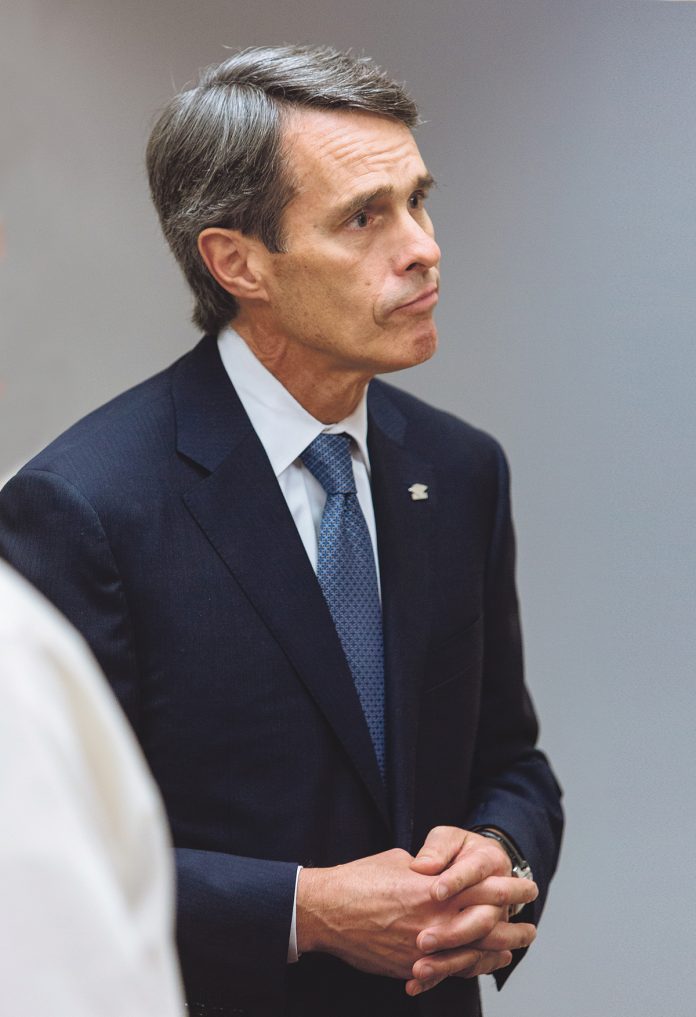William F. Hatfield, Bank of America Corp.’s market president in Rhode Island, discusses the bank’s local growth and ways it can help spur development in areas such as Providence’s Jewelry District.
Bank of America grew its deposits in Rhode Island over last fiscal year by about $5 billion. How did that happen? Actually, [the growth] was across our various lines of business. So those were in-market deposits that you are referring to. And if you look at our consumer and small-business segment, there was growth in that segment. And in our global wealth-investment-management business, we had growth in that segment. In our commercial business, where we have business banking, as well as our money-market customers, we had growth in that segment.
See related story.
With the increase in the bank’s deposits in Rhode Island, will that lead to more lending here? We certainly have the capacity. Capacity is not a constraint. The level of lending is really a function of what is the underlying economic activity that is driving the demand for incremental credit to support our customers.
What are the bank’s branch-office plans for Rhode Island? We look at our branch composition market by market and make investment decisions based on opportunity that we see. I think right now we’re at 30 financial centers in Rhode Island. That’s the number that works for us today. What we’ve done is invest heavily in those financial centers. We have brought all the latest technology – digital technology – that is available. We are in early-market [stages] to adopt all these technologies. We’re seeing phenomenal customer engagement around it.
How is the bank able to achieve that? We’re kind of bringing together the human element – the connectivity, the individual connectivity – with the digital capacity and capability. And that really is, as far as the digital strategy is concerned, the winning strategy. And we’re seeing that connectivity. In this market, we’ve got more than 60 percent of our consumers that are using [digital/mobile-banking services].
How many more customers are using those services than five or 10 years ago? It just didn’t exist then. So that’s the phenomenon. And what we are seeing is, at the financial-center level, it is less a destination for a transaction. It is more a destination for advice and a conversation. We have really introduced an appointment-type culture, where someone on their mobile device can say, “I want to go into a local financial center. I want to go into Kennedy Financial Center and sit down with a relationship manager to talk about a particular need I have.” It may be a home mortgage. It may be planning for retirement. It may be planning for a college education, or maybe a small-business customer. But they can – with their mobile device – book an appointment and a relationship manager is there greeting them.
People are investing and … feeling very good about their economy.
What’s your view of Rhode Island’s current economic conditions? We’ve seen, I think, a very significant movement in optimism. We have experienced a great uptick in how people are feeling about the economy, based on survey results we take and interactions we have with our clients. So, people are investing and, generally speaking, feeling very good about their economy.
How big a role can Bank of America play in state and local efforts to develop the economy, like what is being done to spur redevelopment of Providence’s old Jewelry District? We certainly can support those emerging industries. We can do it with our balance sheet or with a variety of solutions that we offer. … You look at Rhode Island and the assets we have with our universities and our hospitals. Frankly, if you look back over the last 10 to 20 years, we really didn’t nurture those assets the way we should have. And I think there’s been a realization more recently where collaboration is happening, you see that with Brown [University], [University of Rhode Island], around nursing education, around the I-195 area, you see Wexford coming into town.
Why do they want to be here? Because they’re going to be close to Brown, close to URI. There’s going to be a lot of engineering talent that’s developed.
How active do you feel the bank’s role should be? I don’t know if we can be the dealmaker. We need to be at the table and be part of the conversation. And we need to be at the table with our capital. And, where it fits, be prepared to deploy our capital. And that capital is not only money. It’s specific solutions.
How do you feel about fellow banking giant Chase entering the Boston-Providence market in retail banking? We actually compete with Chase everywhere else in the country. Them coming in, I think, says something good about Rhode Island and the market – that there is growth here. I think they’re seeing what we just talked about. … I’d say for Rhode Island, it’s a good thing. And we love the competition.
Scott Blake is a PBN staff writer. Email him at Blake@PBN.com.











